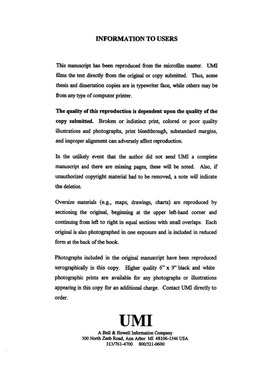| dc.contributor.advisor | Fox, Robert, | en_US |
| dc.contributor.author | Boyce, Kari E. | en_US |
| dc.date.accessioned | 2013-08-16T12:30:34Z | |
| dc.date.available | 2013-08-16T12:30:34Z | |
| dc.date.issued | 1999 | en_US |
| dc.identifier.uri | https://hdl.handle.net/11244/5830 | |
| dc.description.abstract | Field independent participant scores showed an advantage on performance measures. Field dependence/independence was not predictive of learner completion rates, frequency of reporting a sense of 'becoming lost', or navigational style. The results from this study provide a framework for continuing and expanding this viable and relevant area of research. | en_US |
| dc.description.abstract | During a two month period, 114 participants registered and 37 completed all module requirements. The sample population was predominantly practicing, registered sonography professionals and sonography students from Oklahoma and surrounding states. Data analyses included t-tests and chi-square analyses as appropriate for continuous and categorical variables. | en_US |
| dc.description.abstract | The purpose of this study was to determine if field dependent (FD) and field independent (FI) learners differ in performance, completion rates, their sense of 'becoming lost', or navigational style when using WebCT in conjunction with a web browser to access a hypertext continuing professional education module available via the World Wide Web. The educational module content included a pre-module test, a post-module test, seven hyperlinked lessons about ultrasound equipment quality assurance, seven corresponding quizzes, two relevant printable forms, an interactive sonography imaging tool, a glossary and an index. | en_US |
| dc.description.abstract | Learner performance on some module tests and quizzes demonstrated a practical as well as statistically significant difference for FD and FI groups, as expected from review of the literature. Learner completion rates, frequency of reporting a sense of 'becoming lost', and navigational style were not found to be significantly different for FD and FI groups, by practical or statistical standards. | en_US |
| dc.description.abstract | Data was collected electronically via web-based forms and WebCT databases. Each participant was expected to complete a paper and pencil or web-based form of the Hidden Figures Test to establish an individual score along the FDI continuum. Additional demographic, situational and evaluative data were collected via web-based registration and feedback surveys. | en_US |
| dc.format.extent | xii, 207 leaves : | en_US |
| dc.subject | Distance education. | en_US |
| dc.subject | Education, Adult and Continuing. | en_US |
| dc.subject | Continuing education. | en_US |
| dc.subject | Education, Technology of. | en_US |
| dc.subject | Health Sciences, Education. | en_US |
| dc.subject | World Wide Web. | en_US |
| dc.subject | Internet | en_US |
| dc.subject | Psychology, Cognitive. | en_US |
| dc.title | Delivering continuing professional education at a distance: The correlation of field dependence/independence and learning using the World Wide Web. | en_US |
| dc.type | Thesis | en_US |
| dc.thesis.degree | Ph.D. | en_US |
| dc.thesis.degreeDiscipline | Department of Educational Leadership and Policy Studies | en_US |
| dc.note | Source: Dissertation Abstracts International, Volume: 60-05, Section: A, page: 1419. | en_US |
| dc.note | Adviser: Robert Fox. | en_US |
| ou.identifier | (UMI)AAI9933053 | en_US |
| ou.group | Jeannine Rainbolt College of Education::Department of Educational Leadership and Policy Studies | |
